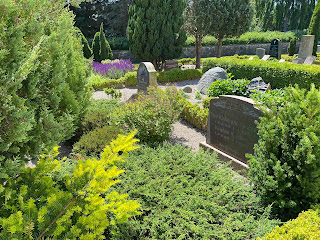At the beginning of June, I went to a Science and Diplomacy conference hosted by La Maison de la Chimie, Paris. I have written about the conference and some of the people I met there.
In addition to listening to some fascinating presentations, the conference itself was like a demonstration of what is lost when conferences are on line or hybrid. I may sound like a kid talking about his favorite parts of school, but it is really true that, for me, the best parts of the two-day conference were the lunches, the dinner, the coffee breaks, and the hallway.
I really liked hearing Matthew Adamson talk about uranium mining as part of his presentation on Cold War weapons and resources. During the break after his talk, we spoke about how resource maps influence industry, and how maps affect military strategy.
During lunch the next day, Adamson and I talked about his career path from grad student in Indiana and Paris, then professor in Budapest. Across from me was Fintan Hoey, a professor of history at Franklin University Switzerland. He is from Ireland, studies the modern of Japan particularly during the Cold War. His best stories were about working in the Italian-speaking part of Switzerland and learning the language of his region.
I turned to my right at the same lunch and talked to Maritza Gomez about her presentation on an attempt by equatorial countries to claim their sovereign territory extended into space, at least as far as the orbits of geosynchronous satellites. She told me about her life in California, then studying in Germany and continuing her studies in Mexico.
Another hallway conversation was with John Krige. He spoke as part of the public panel on the Russian invasion of Ukraine and the effects of Europe stopping all collaboration with Russian scientists just four days after the Russia started the war. Krige's presentation was clear and stark that the war will cause pain across Europe and the world.
At the conference dinner I sat across from Nestor Herran, a professor of the history of science at The Sorbonne in Paris. We talked about his research in Cold War nuclear technology in Britain and elsewhere. I told him I was a Cold War airman on a crew that did live-fire static test of Minuteman missiles and later a tank commander on the East-West German border, so had two different "ground-level" perspectives on the Cold War and the nuclear threat.
After a while, Nestor said, "I am 50 years old and this is the first time I have had a long conversation with a career soldier." We talked about how much the military is separate from the larger culture in countries with voluntary service and who serves in the military. I could tell him I had not met a lot of historians of science in uniform.
Apparently, I am very good at dinner because one of the conference organizers, Charlotte Abney Saloman, invited me to join her and her mom, who was visiting Paris, for dinner the evening the conference ended.
I'm sure I will have to use Zoom in the future for book groups or other events where meeting in person is not possible. But this conference showed me why people get together for conferences. Zoom has no hallways, coffee breaks, or shared meals.

























